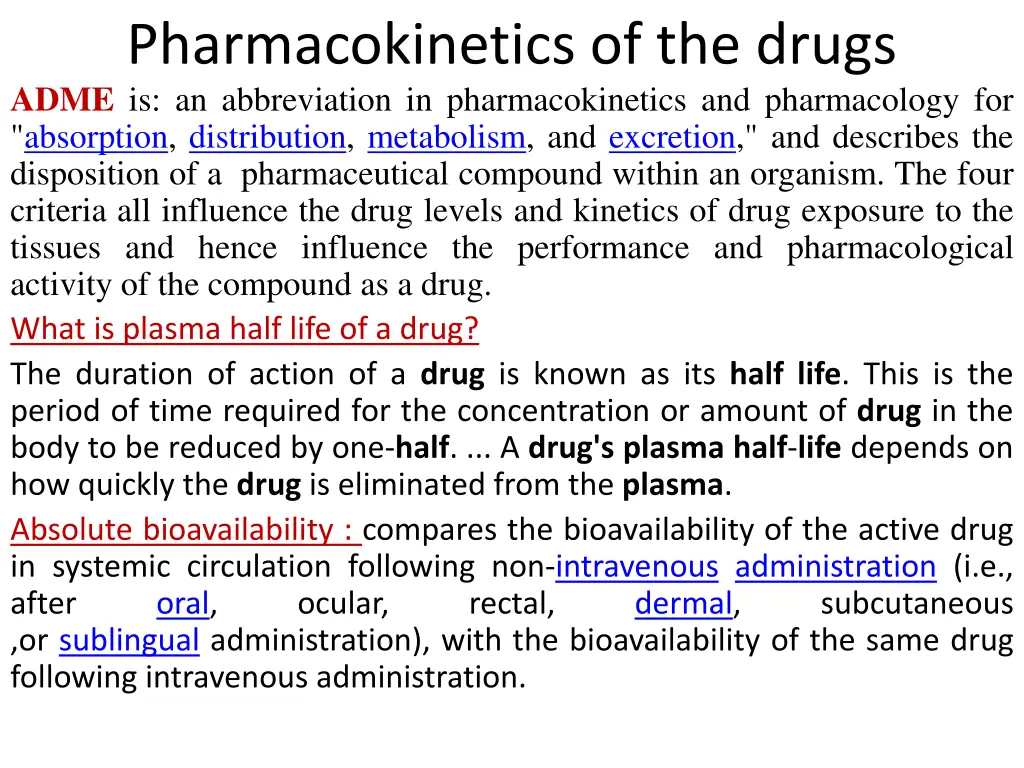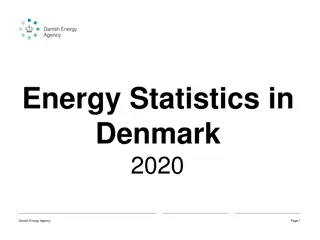
Factors Affecting Drug Plasma Half-Life
Understanding the concept of plasma half-life in pharmacokinetics is essential for assessing drug effectiveness and duration of action. Factors influencing plasma half-life include plasma protein binding, pharmacokinetic patterns, renal/hepatic diseases, active metabolites, enterohepatic circulation, volume of distribution, and rate of elimination. Knowledge of these factors helps in optimizing drug therapy and dosing regimens for improved patient outcomes.
Uploaded on | 9 Views
Download Presentation

Please find below an Image/Link to download the presentation.
The content on the website is provided AS IS for your information and personal use only. It may not be sold, licensed, or shared on other websites without obtaining consent from the author. If you encounter any issues during the download, it is possible that the publisher has removed the file from their server.
You are allowed to download the files provided on this website for personal or commercial use, subject to the condition that they are used lawfully. All files are the property of their respective owners.
The content on the website is provided AS IS for your information and personal use only. It may not be sold, licensed, or shared on other websites without obtaining consent from the author.
E N D
Presentation Transcript
Pharmacokinetics of the drugs ADME is: an abbreviation in pharmacokinetics and pharmacology for "absorption, distribution, metabolism, and excretion," and describes the disposition of a pharmaceutical compound within an organism. The four criteria all influence the drug levels and kinetics of drug exposure to the tissues and hence influence the performance and pharmacological activity of the compound as a drug. What is plasma half life of a drug? The duration of action of a drug is known as its half life. This is the period of time required for the concentration or amount of drug in the body to be reduced by one-half. ... A drug's plasma half-life depends on how quickly the drug is eliminated from the plasma. Absolute bioavailability : compares the bioavailability of the active drug in systemic circulation following non-intravenous administration (i.e., after oral, ocular, rectal, ,or sublingual administration), with the bioavailability of the same drug following intravenous administration. dermal, subcutaneous
Factors affecting plasma Half Life: 1. Plasma protein binding: Protein bound drug produces no effect and is not excreted because proteins are not filtered by glomeruli. It is thus slowly released. Drugs having plasma protein binding have longer half life ( directly proportional). Acidic drugs bind albumin while basic drugs mostly bind globulins. Example includes warfarin, an anticoagulant, having very long half life due to extensive protein binding. The bound drug: Is not distributed to tissues (stays in plasma) Has no pharmacological activity Is not metabolized (no biotransformation) 2. Pharmacokinetic pattern : The rate of absorption, metabolism, biotransformation and excretion are considered in pharmacokinetic pattern. Most important pattern is the pattern of elimination of drug, consisting of: Biotransformation Excretion
3. Renal/hepatic diseases diseases because the elimination is less. Half life is also increased in hepatic diseases because the metabolism is not taking place. Aminoglycosides get accumulated in renal diseases as they are excreted through glomerular filtration 4. Active metabolites: Some of the drugs when taken need to be converted to active metabolites. Thus they have longer half life. Aspirin has a half life of 15 minutes but salicylic acid has half life of 2 hours. 5. Enterohepatic circulation : Some drugs are metabolized in the liver. They are conjugated with glucuronic acid and excreted into the bile. In the intestines, the conjugate is broken down by the bacteria and enzymes. The active drug released and is reabsorbed. These drugs have a longer half life. Examples include rifampicin, doxycycline, and digitoxin. 6.Greater the volume of distribution : more is the half life. 7. Rate of elimination : Rate of elimination is the rate at which drug is eliminated from the body. Drugs having longer half life have more duration of action and vice versa Half life is increased in kidney is
Interval between doses : Time for steady state When the drug is given by constant intravenous infusion or given repeatedly in fixed doses at fixed intervals, plasma concentration of drug rises gradually, and if patient is still taking the drug at fixed intervals and doses, it reaches a peak value and then plateau is reached. This is because the amount of drug being administered is equal to the amount of the drug being eliminated, which is called the steady state. The amount of the dug in plasma becomes constant. This can only be reached when fixed doses of drugs are given after regular intervals After about five plasma half lives the steady state is achieved. Drugs having longer half lives take longer time to reach the steady state. Drugs having longer half lives have no immediate effect.
Clinical Situations involving Increased Half Life Decreased renal plasma flow, e.g. heart failure, cardiogenic shock, hemorrhage. Increased volume of distribution Decreased excretion ratio as in renal diseases Decreased metabolism e.g. cirrhosis of liver. Drugs having half life less than two hours: Aspirin, cephalosporins, heparin, penicillin G :30min Drugs having half life between two to five hours Atropine, cimetidine, indomethacin, paracetamol Drugs having half life between ten to twenty four hours imipramine, practolol Drugs having half life greater than thirty six hours digoxin, warfarin, .






















